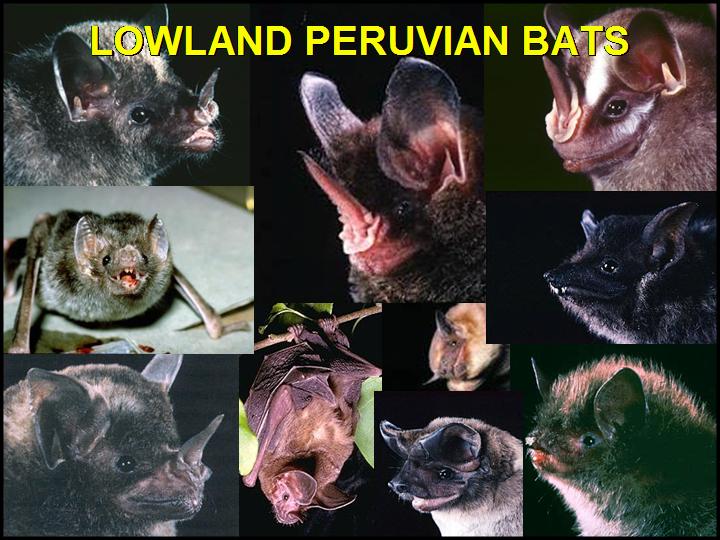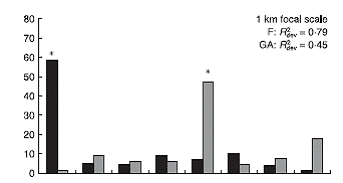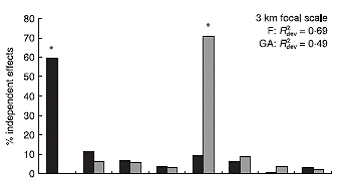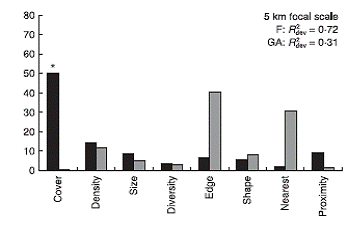Habitat Conversion and Fragmentation |
 |
Habitat conversion in Iquitos.--In contrast to large-scale logging operations typical of the Brazilian Amazon, deforestation in the Peruvian Amazon, especially in the environs of Iquitos, is driven by small-scale subsistence farmers. Deforestation of small 1-2 hectare areas typically takes several days to weeks, during which the understory is removed and most of the trees are felled. The largest trees often are left where they fall. Burning is followed by 2-6 mos of cultivation that results in a plantation covering about 1 ha, which locally is called “chacra”. Chacras typically are planted with pineapple (Ananas comosus, Bromeliaceae), plantain (Musa spp., Musaceae), or manioc (Manihot esculenta, Euphorbiaceae) until the soil is no longer fertile. The influx of pioneer species into abandoned chacras during the subsequent 5 to 10 yrs results in early successional forests that locally are called “purma”. Purma differs dramatically from mature forest in terms of species composition (e.g., Cecropia spp. often dominate) and physical structure (< 10 m canopy, dense understory). Mature upland forest in the region is characterized by high tree diversity with a 30 m canopy punctuated by 50 m emergent trees. Chacra and purma typically have clearly defined boundaries and almost always occur adjacent to mature forest in the Iquitos region. |
| Bats.--In the Neotropics, bats provide critical ecosystem services associated with pollination and seed dispersal. Moreover, because they are the sole or primary agents of pollination and seed dispersal for many species of plants, the Phyllostomidae (i.e., New World fruit-eating bats) may represent a keystone taxon in Neotropical forests. Activities of some phyllostomid species promote secondary succession and regeneration of disturbed areas because they differentially disperse seeds of pioneer species of plants. Seed dispersal by animals is integral to the establishment and persistence of a seed bank that is representative of the local flora. Consequently, understanding the effects of logging regimes on bat populations is critical to designing a forest management program that maintains a high degree of natural ecosystem function in lowland Amazonian rainforests. |
|
|
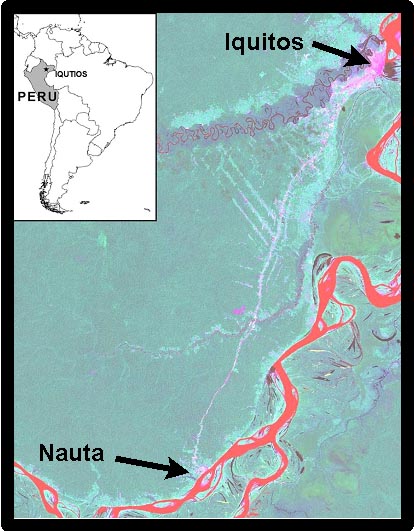 |
| Satellite image of the Iquitos area from 2000 showing mostly intact forest in the region |
|
Study area.--Our research was conducted near Iquitos, Peru. The area is only reachable by boat and by plane; therefore, logging and agricultural practices that fragment forest occur at a modest scale. As a result, large areas of intact forest remain and habitat loss, conversion, and fragmentation generally parallel navigable rivers and, more recently, a 90 km long paved road between Iquitos and Nauta. This paving represented an "improvement" to a previously existing dirt road; however, as the road was paved, rates of forest loss increased along the road. The climate is tropical, with 2800 mm of rain/year that supports humid tropical forests that are dissected by numerous small streams and rivers as well as swamps and inundated lands. Elevations range from 100 m to 220 m, flooded forest (igapo) characterizes low-lying areas, whereas white sand forest (varillal) or upland forest (monte alto) characterize higher areas. |
|
| Data collection and experiment designs.--Funding for work in the Iquitos region was provided primarily by a grant (AI049725) to Dr. Scott Weaver (University of Texas Medical Branch) from the National Institutes of Health through the joint National Science Foundation - National Institutes of Health Program on the Ecology of Infectious Disease. As a result, the primary motivation for the study was the determination of reservoirs and transmission agents of arboviruses. From the perspective of the virus work, the exact location of collection of potential mammalian reservoirs was not always important; therefore, we were able to design sampling protocols that could address ecological questions related to mammals without hindering the search for mammalian virus reservoirs. In total, mammals (bats and small mammals) were collected from well over 100 localities, some of which represented specific experimental designs intended to address specific questions. For example, one group of sites was established to evaluate the effects of habitat conversion on the populations and communities of mammals and another suite of sites were established to evaluate landscape-level questions about the relative effects of habitat composition and configuration on abundance and diversity of bats. |
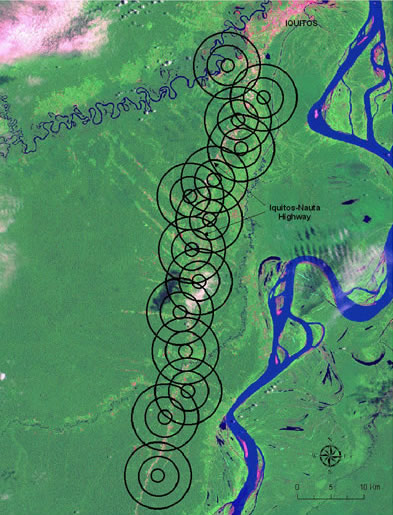 |
| Location of 14 sites south of Iquitos to evaluate the effects of habitat loss and composition on bat abundance and diversity |
|
|
Effects of habitat conversion on species abundance.--The majority of species captured in mature forest also were captured in chacra (agriculture) and in purma (early successional forest). Many species exhibited habitat-specific abundances; however, most of these species exhibited greater abundances in disturbed or early successional habitats that in mature forest. Because many species of bat specialize on the fruits or flowers of early successional plants, abundances of these species may increase locally in response to small scale disturbance. Nonetheless, the continued viability of these populations likely is more reliant on the extensive nearby mature forest that provides roosting habitat as well as adequate forage. Although some species of Neotropical bat generally respond negatively to disturbances, for many species it is possible that a matrix of mature forest with patches of early successional forest that harbor great food resources is a more desirable landscape configuration than a solid expanse of undisturbed habitats.
Effects of habitat conversion on temporal activity of bats.--Species may exhibit many types of responses to habitat conversion, loss, or fragmentation; however, most studies only evaluate changes in species abundance or diversity. Species may exhibit more subtle responses to disturbance that do not manifest as changes in abundance. We evaluated the effects of habitat conversion on the temporal activity patterns of bats. In general, bats were less active early in the night (during twilight) in open habitats than in close canopy forests. This phenomenon is similar to lunar phobia, in which bats avoid times of higher lunar illumination because of increased risk of predation. Bats are slow fliers compared to birds and are easy prey for visually-oriented volant predators in open areas during times of heightened illumination (i.e., full moon, twilight). As open areas become more prevalent in the landscape, it may decrease the amount of foraging time available to bats, which may make it more difficult for bats to meet daily dietary requirements. |
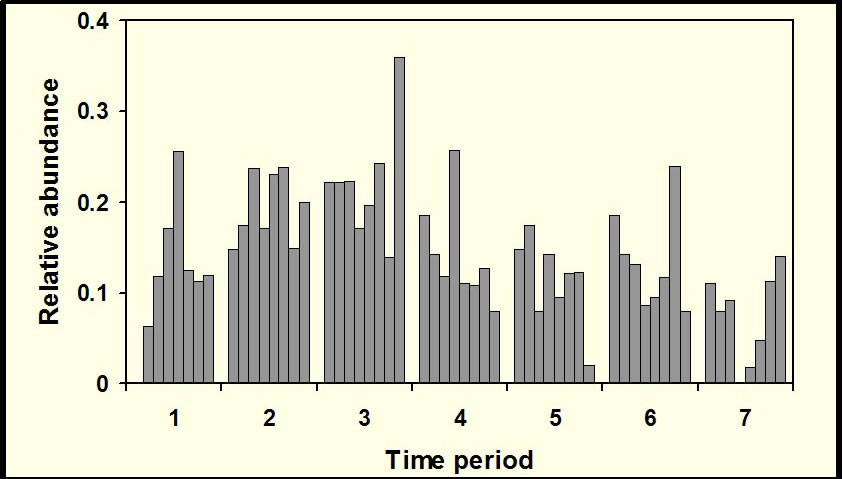 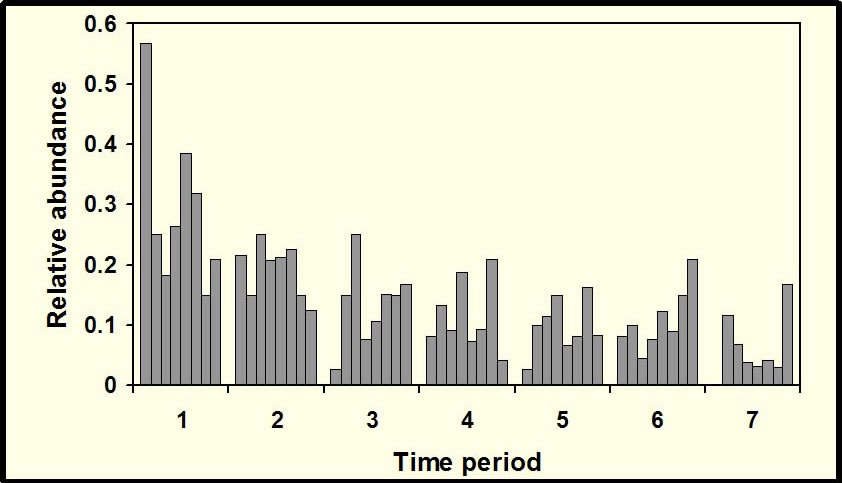 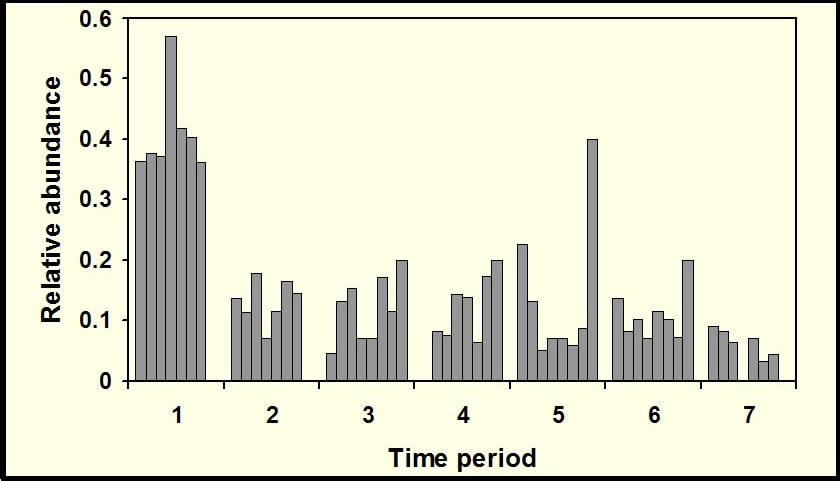 Click for larger figure Click for larger figure |
| Activity patterns of 8 species of frugivorous bat in chacra, purma, and mature forest (top to bottom). Each time period represents 1 hour beginning at sundown. |
|
|
|
|
|
| Percentage of independent effects of compositional and configurational characteristics on abundances of frugivores (black bars) and gleaning animalivores (gray bars) at each of three focal scales. Asterisks indicate significant effects. |
|
Relative importance of habitat composition and configuration.-- For a variety of taxa in a number of habitats, landscape composition rather than spatial configuration has a greater impact on the abundance of species in habitat mosaics. This held true for frugivorous bats (e.g., stenodermatines) in fragmented Amazonian rainforest as well. In contrast, characteristics of landscape configuration had the strongest independent effects on abundances of gleaning animalivores (e.g., phyllostomines). Stenodermatines responded to forest cover, mean patch density, and mean patch size, whereas phyllostomines responded to edge density, mean patch shape, mean proximity and mean nearest neighbor distance. These two observations suggest that modes of foraging and characteristics of prey may mould the landscape level response of bats to fragmentation. Indices of community structure (i.e., evenness and dominance) only responded to configurational metrics, but no landscape characteristic had a significant independent effect on richness, diversity, or rarity at any scale despite multiple species-specific and ensemble-specific responses at all scales. |
|
Collaborators on Amazonian Habitat Conversion Research
|
Related Manuscripts
Hice, C.L., P.M. Velazco, and M.R. Willig. 2004. Bats of the Reserva Nacional Allapahuayo-Mishana, northeastern Peru, with notes on community structure. Acta Chiropterologica 6:319-334.
Willig, M.R., S.J. Presley, C.P. Bloch, C.L. Hice, S.P. Yanoviak, M.M. Díaz, L. Arias Chauca, V. Pacheco, and S.C. Weaver. 2007. Phyllostomid bats of lowland Amazonian: effects of habitat alteration on abundance. Biotropica 39:737-746.
Presley, S.J., M.R. Willig, I. Castro-Arellano, and S.C. Weaver. 2009. Effects of habitat conversion on activity patterns of phyllostomid bats in lowland Amazonian rainforest. Journal of Mammalogy 90:210-221.
Klingbeil, B.T., and M.R. Willig. 2009. Guild-specific responses of bats to landscape composition and configuration in fragmented Amazonian Rainforest. Journal of Applied Ecology 46:203-213.
Klingbeil, B. T., and M. R. Willig. 2010. Seasonal differences in population-, ensemble- and community-level responses of bats to landscape structure in Amazonia. Oikos 119:1654-1664. |

